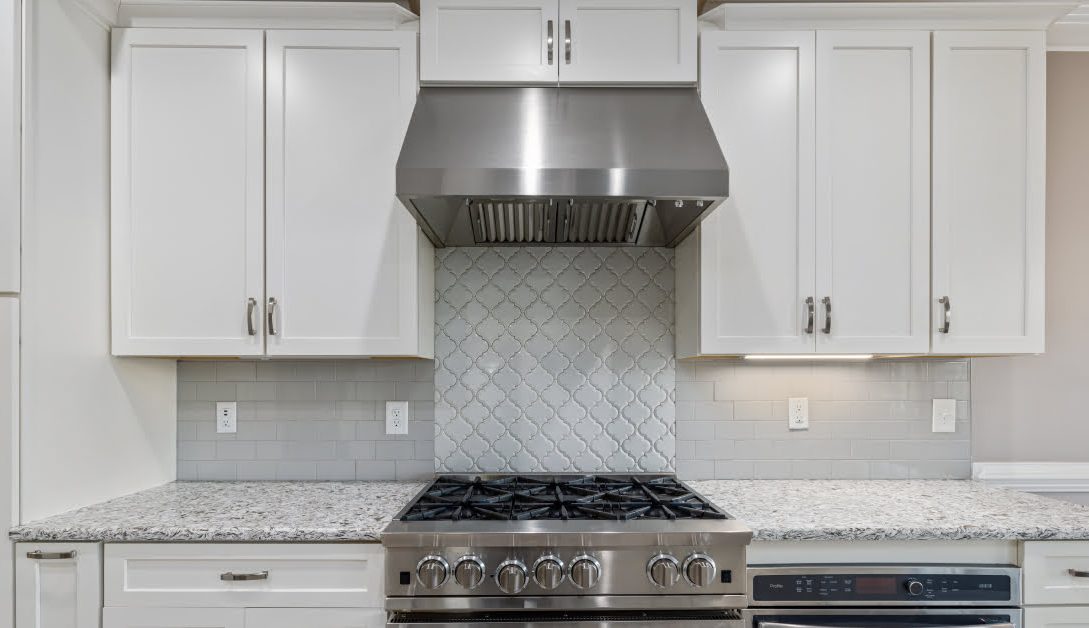To clean a range hood fan motor, first, turn off the power source and remove the fan blades. Clean the motor with a soft-bristled brush and a mixture of water and mild detergent.
A range hood is an important appliance in the kitchen that helps in removing smoke, steam, and grease from cooking. With time, the range hood fan motor can accumulate dirt and grime, leading to reduced efficiency and increased noise. Thus, it is important to clean the range hood fan motor to maintain its functionality.
However, cleaning the fan motor can be a daunting task for some since it involves electrical components. This article will provide you with a step-by-step guide on how to safely and effectively clean a range hood fan motor to keep it running smoothly.

Credit: www.youtube.com
Understanding Range Hood Fan Motor
Basic Functionality Of A Range Hood Fan Motor
A range hood fan motor is one of the most crucial components of your kitchen ventilation system. This fan motor draws all the smoke, heat, and unwanted odors that are produced when cooking from your kitchen and pushes it outside.
The process of removing such elements is made possible by the motor which rotates the fan blades, creating suction that pulls the air into the hood.
To ensure proper functionality of the fan motor, proper installation, and appropriate control features that are fitted with your range hood is paramount. If any of the components that make up the motors fail to function correctly, the whole kitchen ventilation system may fail to work optimally.
Here are some of the crucial components that work jointly to enable proper functioning of the range hood fan motor:
- Fan blade: The fan blade pulls smoke, heat, and smells from the kitchen and disperses them outside.
- Motor: The motor powers the fan blade to create suction.
- Controls: Control panels help you adjust the settings of the fan motor, so it works efficiently.
- Ductwork: Ducts work by carrying smoke and other undesirable elements produced in the kitchen to the outside, enhancing the fan motor’s work efficiency.
Importance Of Regular Cleaning
Cleaning your range hood fan motor should be a top priority in maintaining your kitchen ventilation system. The fan motor is responsible for sucking in smoke, steam, and other grease that clings to the motor blades, which can cause the motor to work inefficiently.
Failing to clean your range hood fan motor frequently could lead to:
- Reduced air quality: An unclean range hood fan motor may distribute smoke, steam, and other unwanted elements in the kitchen, reducing the air quality.
- Damaged motor: Without proper cleaning, debris that accumulates in the range hood fan motor blades might cause the motor to fail.
- Fire hazards: Grease buildup from cooking can ignite and cause a fire that can be extremely dangerous.
To avoid these issues, regular cleaning of your range hood fan motor is essential. Cleaning your motor blades, wiping the exterior of the range hood, and checking the controls can enhance the working efficiency of the motor and reduce the risk of fire.
Significance Of Proper Maintenance
Proper maintenance of your kitchen ventilation system, which includes your range hood fan motor, is essential. You can extend the life of your range hood fan motor by taking proper maintenance measures. Here are some of the benefits of maintaining your range hood fan motor with the right cleaning schedule:
- Better working efficiency: A clean range hood fan motor will work more efficiently, allowing you to smoke, steam, and other unwanted elements from your kitchen space quicker.
- Improved air quality: A clean range hood fan motor improves air quality by providing proper air purification and distribution.
- Extended lifespan: Regular cleaning and maintenance can extend the lifespan of your range hood fan motor.
To make sure your range hood fan motor functions efficiently, it’s essential to assure proper installation, cleaning, and maintenance regularly. Doing so will keep your kitchen air clean and safe to breathe, and, most importantly, reduce the risk of accidents.
Signs That Your Range Hood Fan Motor Needs Cleaning
Are you experiencing reduced airflow in your kitchen? Or perhaps, you’ve noticed strange noises coming from your range hood fan motor? Maybe you’ve noticed that your range hood fan motor is unable to extract smoke, steam, or heat from your kitchen.
These are all indicators that your range hood fan motor needs cleaning. Neglecting to clean it regularly could lead to reduced efficiency and costly repairs. In this blog post, we will highlight the key signs that your range hood fan motor needs cleaning, so you can take the necessary steps to maintain your range hood.
Reduced Airflow In Kitchen
Reduced airflow in your kitchen is one of the key signs your range hood fan motor needs cleaning. Some of the causes of reduced airflow may include a dirty fan motor, clogged filters, or ductwork obstruction. Here are the key points to keep in mind:
- Reduced airflow results in poor ventilation, which could lead to health issues and discomfort in the kitchen.
- Dirty fan motors and clogged filters may lead to increased power consumption, which could result in increased electrical bills.
- Cleaning the fan motor and filters regularly will improve airflow in your kitchen.
Strange Or Unusual Noises
Another sign that your range hood fan motor needs cleaning is if you hear strange or unusual noises coming from your range hood fan motor. These may include vibrating, screeching, or grinding noises. Here’s what you need to know:
- Strange noises are a sign that something is wrong with the fan motor and cleaning is required.
- Vibrating noises may result from loose blades, while screeching noises may indicate that the fan motor needs lubrication.
- Ignoring these noises may lead to costly repairs or replacement of the fan motor.
Inability To Extract Smoke, Steam, Or Heat
If your range hood fan motor is unable to extract smoke, steam, or heat from your kitchen, it’s a clear indication that it needs cleaning. Listed below are some of the key points to keep in mind:
- An inability to extract smoke, steam, or heat from your kitchen could lead to the formation of mold and mildew, resulting in poor indoor air quality.
- The buildup of grease and debris in the fan motor and filters may cause the fan motor to work harder, leading to slower extraction rates.
- Regular cleaning of the fan motor will help it to extract smoke, steam, and heat more efficiently, thereby improving the air quality in your kitchen.
Knowing the signs that your range hood fan motor needs cleaning is crucial to ensure optimal performance and maximum efficiency. Regular cleaning of the fan motor, filters, and ductwork will improve airflow and reduce the risk of costly repairs. So, make sure to clean your range hood fan motor regularly to enjoy a comfortable and healthy kitchen environment.
Easy Cleaning Tips For Your Range Hood Fan Motor
Range hood fan motors are a crucial part of your kitchen exhaust system. It keeps smoke, fumes and humidity out of your kitchen, preventing the build-up of grease and grime on your surfaces. Over time, these components will naturally accumulate such impurities, hence requiring a deep clean.
However, cleaning a fan motor of a range hood may seem like a daunting task. You might worry about doing it right and doing it safely. But worry not! With the right tools, techniques and safety measures, you can deep clean the range hood fan motor without sweating.
Required Tools And Techniques
To clean your range hood fan motor the right way, you will need a few specific tools. Here are the essential tools to gather before you start cleaning:
- Gloves, goggles and a mask to protect yourself from grease and other harmful particles.
- A screwdriver to remove the fan and motor.
- Nut driver or pliers to remove nuts or screws holding the components in place.
- A cleaning solution, such as warm soapy water, commercial degreasers, or ammonia-based cleaners.
- A soft-bristled brush, such as a paintbrush or an old toothbrush, to loosen dirt and grime.
- A clean rag or towel to wipe away grime and polish surfaces.
Once you have all the tools you need, follow these simple steps to clean your range hood fan motor safely:
Step-By-Step Cleaning Process
- Disconnect the range hood from your electricity source. This ensures that the motor is not running while you are cleaning it.
- Locate and remove the screws or nuts that secure the fan and motor assembly in place. Be gentle, as these are delicate components.
- Soak the fan and motor in warm soapy water or cleaning solution, and allow it to sit for a few minutes. This will loosen the dirt and grime.
- Use a soft-bristled brush to scrub the fan blades, motor, and any other parts that have accumulated grease and grime. Do this gently as you do not want to damage any components.
- Wipe away the loosened dirt and grime with a clean, damp rag or towel.
- Give the components some time to air dry and wipe them with a dry rag or towel.
- Put everything back together and reconnect your range hood to the electricity source.
Safety Measures To Follow
When cleaning your range hood fan motor, it is vital to observe safety precautions. Here are a few safety tips you should follow to help you avoid injuries or damages:
- Always wear protective gloves, goggles, and a mask while cleaning to protect your eyes, skin, and respiratory system from grease and grime.
- Make sure you disconnect your range hood from any electrical source to prevent electrical shock.
- Do not use steel wool or abrasive cleaners, as they can cause physical damages to your range hood’s components.
- Do not press too hard on the components when cleaning, as you may cause permanent damages.
Follow these easy cleaning tips, and your range hood fan motor will be sparkling clean and running smoothly in no time. Remember to observe all the safety measures we have outlined above, and you will have a clean, safe, and efficient kitchen exhaust system.
How To Clean Range Hood Filters
Range hoods are a significant part of any kitchen, as they help to eliminate heat, smoke, and unpleasant cooking odours. However, when grease and grime build upon the range hood, it can affect its performance. Cleaning range hood filters is an essential activity to maintain the range hood’s proper functioning.
This article will outline the various techniques for cleaning the range hood filters.
Basic Cleaning Techniques
Cleaning range hood filters is not a difficult task when you know how to do it. Here are the basic cleaning techniques:
- Remove the range hood filters from the hood and use hot water to dampen them entirely. You can use a garden hose to do this, but if that is not possible, use your sink.
- Add some dish soap or mild detergent to the water and allow the filters to soak for about five minutes.
- Take a non-abrasive brush, such as a scrub brush or toothbrush, and carefully scrub the range hood filters. Make sure you scrub every part of the filters.
- Use water to rinse the filters again and repeat this process until all the grease and grime have been removed.
Chemical-Free Solutions
For some individuals, using chemicals isn’t their first choice when it comes to cleaning tasks, including cleaning range hood filters. Here are some chemical-free solutions to clean your range hood filters:
- Baking soda is a gentle, non-abrasive cleaner that can be used to clean range hood filters. Create a paste by mixing a 1/2 cup of baking soda with enough water to form a thick paste and cover the filters. Wait a few minutes and then scrub the filters with a brush before rinsing with water.
- Another natural solution to cleaning range hood filters is vinegar. Soak the filters in a bowl of hot water and half a cup of vinegar for 10-15 minutes. Take the filters out of the mixture, rinse them with water, and dry them with a towel.
Reinstalling The Filters
After cleaning the range hood filters, it’s essential to reinstall them correctly. Here are some tips to follow:
- Ensure that the filters are entirely dry before you install them.
- Reinstall the filters correctly and ensure that they sit securely in their original position. Ensure that all fasteners or clips are in place.
- After reinstalling the filters, test the hood to ensure it runs as expected, with no unusual noise or smoke.
Keeping your range hood filters clean is critical for maintaining a healthy kitchen and ensuring your range hood functions correctly. The basic cleaning techniques, chemical-free solutions, and guidelines for reinstalling the filters outlined above provide a comprehensive and effective cleaning process.
How To Clean Greasy Range Hood Fan Blades
If you’re a cooking enthusiast, you’re aware of the importance of maintaining your kitchen’s hygiene. One of the most commonly overlooked areas in your kitchen is the range hood fan blades. As time goes by, it can collect a considerable amount of grease, resulting in a dirty and unsanitary environment in your kitchen.
However, with the right tools and professional cleaning tips, you can tackle this issue with ease.
Required Equipment And Tools
Before starting the cleaning process, make sure you have the following items on hand:
- Screwdriver
- Dishwashing liquid
- Hot water
- Sponge or cloth
- Bristle brush
- Soft-bristled brush
- Plastic bag
- Painter’s tape
Step-By-Step Cleaning Process
Follow these detailed steps on how to clean your greasy range hood fan blades with ease:
- Turn off power: Ensure to turn off power to the range hood before beginning to clean the blades. Most range hoods have exposed wires, which can cause electrical shock. If there’s no power-off switch in your range hood, turn off the power at the circuit breaker.
- Remove the fan blades: Before removing the blades, use painter’s tape to mark them. This preservation will make it simpler when it comes to reinstalling them. Using a suitable screwdriver, remove the fan blades.
- Clean the blades: Create a mixture of dishwashing liquid and hot water. Dip the sponge in the water, squeeze out the excess water, and clean the blades. Use a bristle brush to remove stubborn gunk from the fan blades’ crevices. Follow up with a soft-bristled brush to get into the nooks and crannies of the fan blades.
- Dry the blades: Wipe the fan blades dry with a dishcloth, making sure the blades are entirely dry before reinstalling them.
- Reinstall the fan blades: Put the fan blades back in place carefully. Remove the painter’s tape and turn the power on to ensure the fan blades are working correctly.
Alternative Solutions
Although dishwashing liquid is exceptional in removing grease from the fan blades, there are other solutions you can use:
- Baking soda: Combine 1/2 tablespoon of baking soda and hot water to create a paste to clean grease from the fan blades.
- Vinegar: Mix equal parts of white vinegar and water to decrease stubborn grease on the fan blades.
- Lemon: Dab a sponge with lemon juice and hot water to remove grease from the fan blades.
Final Thoughts
Keeping range hood fan blades clean is a crucial aspect of maintaining a clean kitchen. However, by following these requisite steps, you can efficiently clean your fan blades and maintain a healthy environment for cooking. With the necessary cleaning equipment and tools, repetitive cleaning, upkeep on your range hood fan blades will become routine.
When To Seek Professional Help
Range hood fans play a crucial role in keeping the air in your kitchen clean and fresh. Over time, the fan motor can accumulate grease and dust, and without proper cleaning, it can quickly lead to issues. Knowing when to seek professional help to clean your range hood fan motor is essential to ensure it functions at its best.
Here are the signs capable of leading to collateral damage, the requirement of professional services, and how to hire a professional range hood fan motor cleaner.
Signs Capable Of Leading To Collateral Damage
Several signs indicate it’s time to clean your range hood fan motor. These include:
- The fan makes unusual noises when turned on.
- You notice a strong odour of grease in your kitchen.
- Smoke starts to build up when cooking, and the fan fails to clear it out.
- The performance of the fan decreases, and its ability to extract air from your kitchen declines.
If you notice any of these signs, it’s time to clean your range hood fan motor.
Requirement Of Professional Services
Cleaning your range hood fan motor requires professional expertise and equipment. Trying to tackle the cleaning on your own can lead to damage and costly repairs. Professional services ensure your range hood fan motor is cleaned, and the proper lubrication is done.
Here are some of the professional services you can expect:
- The cleaning of your range hood fan motor and fan blades.
- Proper lubrication of the motor bearings to enhance performance and longevity.
- A full inspection of the range hood to identify any other potential issues and any needed repairs.
Hiring A Professional Range Hood Fan Motor Cleaner
When looking to hire a professional range hood fan motor cleaner, it’s essential to consider the following:
- Do your research and inquire about the company’s experience and expertise.
- Check their reviews and testimonials before hiring.
- Ensure they have the right equipment and cleaning solution for the job.
- Request a quote and do a price comparison with other companies.
- Ask for a written service guarantee to ensure you get the best value for your money.
Hiring a professional range hood fan motor cleaner is the best way to maintain your range hood’s functionality and longevity. With the right services, you can avoid costly repairs and ensure optimal performance.
Frequently Asked Questions Of How To Clean Range Hood Fan Motor
How Frequently Should I Clean My Range Hood Fan Motor?
It is recommended that you clean your range hood fan motor at least twice a year to ensure that it functions optimally.
Can I Detach My Range Hood Fan Motor?
Yes, you can detach your range hood fan motor by following the manufacturer’s instructions and guidelines on how to do it properly.
Are There Any Safety Precautions I Need To Take When Cleaning My Range Hood Fan Motor?
Yes, you need to ensure that the power supply is disconnected and the fan motor is cool to touch before cleaning to prevent accidents.
Can I Clean My Range Hood Fan Motor With Soap And Water?
No, it is not recommended to clean your range hood fan motor with soap and water as this can damage the motor’s electrical components. Use a degreasing solution instead.
How Can I Tell If My Range Hood Fan Motor Needs Cleaning?
If you notice that your range hood fan is producing more noise than usual, it is a sign that it needs cleaning. Other signs include slow rotation and poor ventilation.
Do I Need Any Special Tools To Clean My Range Hood Fan Motor?
No, you do not need special tools to clean your range hood fan motor. All you need is a degreasing solution, a clean rag, and a brush.
Conclusion
Regular cleaning of your range hood fan motor is essential to keep your kitchen area hygienic and odor-free. Neglecting this task can result in the accumulation of grease and dirt in your fan motor that can impact its functioning and eventually lead to unsafe and unclean kitchen conditions.
With a few basic steps, you can easily clean your range hood fan motor, both inside and out. Always ensure to turn off the power supply and consult the manual for specific cleaning instructions before starting the cleaning process. A few tools, such as a screwdriver, soap solution, and a cleaning brush, are all that you’ll need to maintain this important part of your kitchen.
Remember to clean it on a routine basis to avoid problems in the long run. Keep a regular check on the cleanliness of your range hood fan motor to ensure that your kitchen is a healthy and safe place for cooking!

Freda is a passionate foodie and kitchen gadget enthusiast. With over 10 years of experience in the culinary industry, Freda brings her expertise in testing and reviewing kitchen gadgets.




